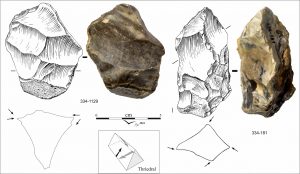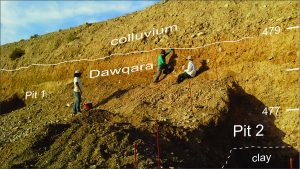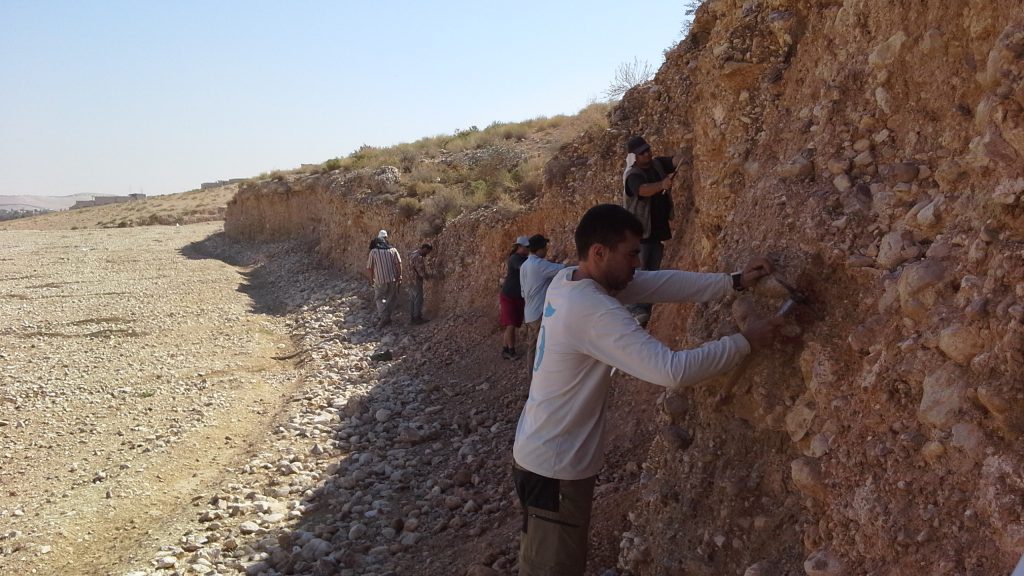São Paulo – With a discovery made in Jordan, Brazilian researchers may change what science thinks about human evolution and the migration of species. The study published at the Quarternary Science Reviews this month found chipped stone tools from 2.4 million years ago, the earliest ones found outside Africa. Therefore, the study suggests that the first members of the genus Homo to leave the African continent were the Homo habilis, not erectus, approximately 2.4 million years ago, that is 500,000 years before it was believed before.
The research started in 2013 and was headed by the Brazilian Walter Neves, a senior professor at the Institute of Advanced Studies (IEA) at the University of São Paulo (USP), who supervised the study on “Luzia,” the oldest human skeleton in the Americas. The mission was carried out at the Zarqa River Valley in North Jordan and financed mostly by the São Paulo Research Foundation (Fapesp) and the Wenner-Gren Foundation for Anthropological Research in New York.

Homo habilis used to build a chipped stone industry called Oldowan, such as those the team found in Jordan. “A chipped stone is an evidence. This documents that there was an intelligent life. The Middle East isn’t favorable to the fossil preservation, but you can find human evidence here,” explained team’s researcher Giarcarlo Scardia, an Italian-Brazilian that works at the Institute of Geosciences and Exact Sciences at São Paulo State University (Unesp).
Named “Hominin biocultural evolution at Zarqa river valley, Jordan: a paleoanthropological approach,” the project also featured the Brazilian Astolfo Araújo, with the Archeology and Ethnology Museum at USP; the Italian Fabio Parenti, with the Anthropology Department at the Federal University of Paraná (UFPR) and Istituto Italiano di Paleontologia Umana; as well as colleagues for analysis in the United States and Germany.
Who left first: erectus or habilis?
Until now, it was believed that the first to leave Africa 1.9 million years ago was the Homo erectus, who arrived at the Caucasus, the region between the Eastern Europe and the Western Asia, approximately 1.8 million years ago, as shown by the discovery of the paleoanthropological site in Dmanisi, Georgia. However, five skulls found in Dmanisi show a great variability, which makes their classification very controversial.

The model proposed by the Zarqa Valley findings has it that the Homo habilis appeared in Africa around 2.5 million years ago and arrived at the Middle East about 2.4 million years ago, from where he spread throughout the world, including to the Caucasus, about 1.8 million years back. In the Caucasus, the habilis supposedly originated the Homo erectus, who later migrated to places including Africa.
For Scardia, who dated the artifacts, the finding helps clear up several mysteries surrounding the history of hominids. “Up until a few years ago, people were still questioning whether Africa was really the birthplace of mankind, because there’s a lot of ancient items in Asia. Asia was a secondary birthplace. Now we have the evidence to prove it. Assuming there was migration to Asia very long ago, this migration is very likely to have informed other species,” he said regarding the Georgia case.
The research in Jordan also provides a new explanation for another controversial subject in paleoanthropology: the Homo floresiensis, The research in Jordan also provides a new explanation for another controversial subject in paleoanthropology. The researchers believe that if the habilis was the first hominid to leave Africa was, the “Hobbit of the Island of Flores” is easier to explain. He could have been the result of a shrinking of the habilis – which was also very low in stature (about 1.2 m) and with a very small brain (650 cm3) – rather than of the erectus – which was 1.17 m tall – as many would believe.
What changes after all?
But what’s the meaning of that in practical terms? “It changes a lot of things. It’s a paradigm shift. (The study) is proposing a change in how the realm of micro and macro human evolution are populated. It’s called the complementary model. You need to revise all fossil and artifact collections to reread and present the results and reestablish what happens as a result of the occupation by the habilis predating event that of the erectus,” Federal University of Pernambuco (UFPE) Archaeology professor Sérgio Monteiro told ANBA.

For Monteiro, this is the moment for the science community to reflect and look into how the interpretations of evolution can be from now on. “When you’re dealing with human fossils, you’re working with puzzles. There are problems with identifying the species with precision. It’s an extremely complex research activity. Saying that the artifacts you found contain indications of Homo habilis is like a relative answer, it’s not comprehensive yet. Since he found the artifact,s research must continue until more are found. Only there’s a problem: many places in the planet are not amenable to the conservation of bodies,” pondered Monteiro.
The field work
In 2013 the team took its first trip to the region in Jordan that they picked on the basis of the prior knowledge of researcher Fabio Parenti, who’d worked there during the 90s. “We spoke with people at the Department of Antiquity of Jordan, and we visited the archaeological dig area. We were very well received and made some great contacts,” explained Scardia. The following year saw the team go out in the field for the first time for one month, followed by another month in 2015 and ten days in 2016. In 2017, back in Brazil and with the collected samples on hand, the scientists began to analyze the material.

Out of the hundreds of items analyzed, three were kept at the USP, and the remainder were returned to Jordan. Scardia said the biggest challenges doing field work were the culture and language differences. “The language issue got solved quick. We met highly motivated young people who spoke fluent English and Arabic. We were super glad, because it’s a peaceful country,” he said.
The culture shock came from the volunteer team of students and researchers, most of whom were women – some of the Jordanian assistants were taken aback. “But that didn’t cause any drama. Jordan is a free country that’s very open and safe,” said Scardia. “During the time we were there, we were near the Syria war, but working in Jordan was easy because they are very professional. That made a big difference when it comes to the project’s success. There was a lot of positive dialogue with the Jordanians,” he said.
Back to Jordan
Now, the researchers hope to keep doing field work.” This (the finding) is absolutely groundbreaking. Would it be possible? Yes. But the artifact material alone isn’t enough. It’s a scientific problem. I’d like to look at the [habilis] skeletons. We worked with vestiges, and they have the lithic (stone) artifacts. You need more, and that’s what the researchers are going after: more,” said Monteiro of the UFPE regarding the chipped stone artifacts.
The next step is to get the funding. “The work isn’t done yet; We need to keep adding to this research. We want to go back to Jordan next year. We have questions: What were the means these hominids had to survive in Jordan? How was it possible? What was the climate like?”, inquired Giancarlo Scardia.
Here’s Walter Neves’ interview with TV USP (in Brazilian Portuguese):
Translated by Guilherme Miranda & Gabriel Pomerancblum




